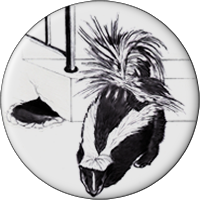ArticlesLiving/Coping With Urban Wildlife Calgary is a unique city with its two rivers, tributaries, parks and natural green spaces. These become natural corridors for wildlife. Combined with the manmade corridors, in the form of roadways, citizens experience encounters with wildlife. The existence of wildlife in urban areas enriches our environment, bringing a little bit of nature to the bustle of the city. Abundant food and shelter and the absence of natural predators have allowed many wild animals to successfully adapt to urban life. We can hardly blame them for helping themselves to food that is readily available and accessible in garbage containers, gardens, composters and sheds. We should consider ourselves fortunate to live in a part of the world where we can enjoy wildlife in our cities and our own backyards. It is one of the benefits of living in a country rich in natural resources. However, urban wildlife are opportunistic and their instinct to find food and shelter sometimes causes conflict with people. These urban animals are naturally drawn to warm, dry places (i.e. your house, chimney, deck or shed). This is a natural behaviour for them and they should not be treated as vermin. At Calgary Humane Wildlife Control (CHWC), we understand that animals do not damage our homes out of ill intent or malice. They are simply and innocently just trying to survive. Everyday CHWC works to educate the public on the importance of prevention. We believe that wildlife in our cities deserves our respect and kindness, and with good structural prevention we can keep human/wildlife conflict to a minimum. It is important to keep in mind that urban wildlife are not pets, but are not truly "wild" either. They have adapted quite well to living in urban and suburban areas and may not be as afraid of people as their wild cousins. These animals need to be treated with respect. They may be cute looking, especially the babies, but can become aggressive if threatened and may also carry diseases that are harmful to humans. It's best to view them from a distance. Believe it or not the familiar and obnoxious smelling skunk is one of our most beneficial animals. It is estimated that 70% of the skunks’ diet benefits people as it consists of mainly insects and small rodents such as mice. Despite this, skunks may cause problems when they decide to live under our steps, decks, sheds, and homes. Provincial and municipal wildlife control departments have been moving away from trapping as a tactic for urban wildlife management because prevention has proven to be the most effective way of controlling animals in the city. Live trapping and relocation is not a long-term or humane solution. Trapped animals often suffer severe stress, injury and sometimes death in their attempts to escape. Trapping often separates mothers from their young resulting in the agonizing death of the young. Even when an entire family is captured and relocated, the mother may abandon her young at the new site due to pressure to find food and care for her young. Relocation not only fails to solve local problems, but often creates new problems at the release site by upsetting the natural balance of existing resident populations. As well, relocated animals often face starvation unless there are adequate food sources and territorial challenges from existing animals that can result in injury or death. Taking measures to prevent animals from entering your house or damaging your property can be much more effective than trapping, which ultimately allows more animals to move into the area. If there is ample food and a place to live, removing the resident animal will just create a vacant territory for another one to move into. Preventive measures have proven to be less costly and less stressful for both wildlife and the homeowner in the long term. CHWC uses species specific techniques that are based on the biology and habits of urban wildlife. These techniques have proven to be successful for more than 25 years. Humane wildlife control requires in depth knowledge through extensive training and experience. Understanding an animal’s biology and behaviour during the different seasons is a prerequisite to successfully solving wildlife intrusions and preserving customer satisfaction. Most companies advertise the humane removal of wildlife, but the wildlife control industry in Canada is largely unregulated. So you should ask specific questions about the methods of removal to ensure the animals will be treated humanely. What will they do about getting babies as well as adults? Do they charge per animal removed? Specifically, what happens to the animals? What do they do to prevent the situation from ever happening again? You should also check with the local humane society or SPCA regarding the companies’ credibility. Make sure you have a firm agreement with the company about the methods used to remove the animals and, importantly, a written guarantee on their work. Humane wildlife control requires in-depth knowledge through extensive training and experience. Understanding an animal’s biology and behaviour during the different seasons is a prerequisite to successfully solving wildlife intrusions and preserving customer satisfaction. Calgary Humane Wildlife Control promotes coexistence with wild neighbours, and educates the public on ways to limit these resources around properties, reducing the potential of animals gaining access to homes. In addition, using proven exclusion techniques our service prevents hundreds of unnecessary wildlife deaths and separation of wild families. CHWCs’ team is lead by Alberta’s first Certified Urban Wildlife Control Technician who, as a wildlife zoologist, has more than 15 years experience in dealing with human/wildlife conflict situations. So really, there is only one call you need to make if you or a friend is experiencing a wildlife intrusion, CHWC at 587-888-9453 (WILD). By Ken Cheek, CHWC |


